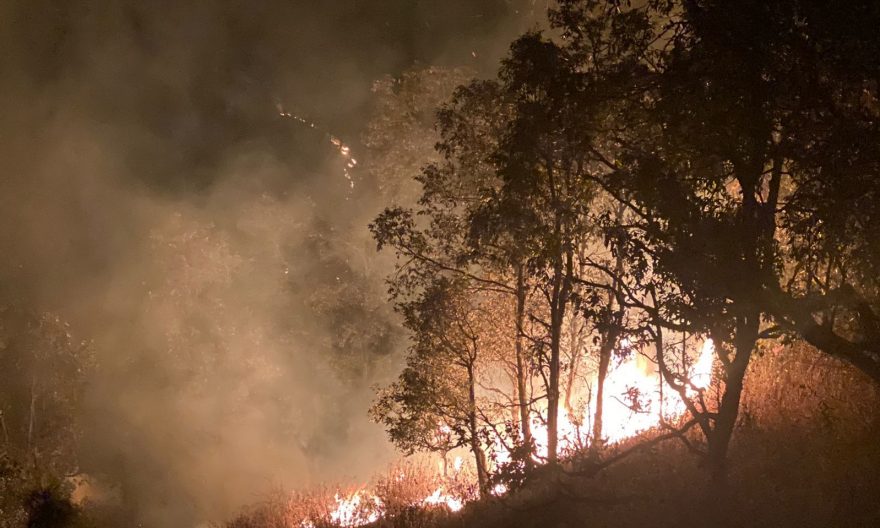
Forest fires have become regular events in Uttarakhand. The state is losing thousands of hectares of forest wealth every summer. The loss of trees and shrubs can be measured, but it is difficult to estimate the damage in terms of losses of birds’ nests, eggs, hatchlings; reptiles; and small animals burnt in fire. The truth is that no effort has been made to assess the loss of flora and fauna. When forest fires break out, the government, society, and environmentalists spring into action, but they go missing once the fire gets extinguished by rains and the greenery returns.
The State of Forests Report -2019 (ISFR 2019) has estimated that that recurrent forest fires occur in more than 36% of the country’s forest areas. According to the report, about 4% of the forest cover is prone to fire, while 6% is prone to extreme fire. Apart from this, 54.40% of the forests have been exposed to occasional fires, 7.49% to moderately frequent fires, and 2.40% to high incidence level of fires. It is a matter of relief that 35.71% of India’s forests have not yet been exposed to fires of any real significance.
According to the ministry of environment, forest and climate change report, the government has used state-of-the-art instruments such as moderate resolution imaging spectro-radiometer sensor and detected 52,785 forests fires between November 2020 and June 2021. Similarly, with the Suomi National Polar-orbiting Partnership – Visible Infrared Imaging Radiometer Suite, the country has detected 3,45,989 incidents of fire in the same period.
READ I India’s green hydrogen drive faces heavy odds
Uttarakhand was formed on November 9, 2000. According to a report of the forest department, the state has been losing forest wealth to fires at the rate of 24 square kilometres per annum in the last two decades. This is despite the fact that the state government has a considerable number of highly qualified and trained officials in the forest department. Moreover, the world-class Forest Research Institute is situated in Dehradun, the capital of the state. As a premier forest research organisation, the FRI must be working on the causes of forest fires and preventive measures.
The Uttarakhand forest department has done several experiments in the last two decades and spent millions of rupees on technology and training. All these efforts seem to have failed as the department remains clueless when incidents of fire occur. The situation has come to such a pass that the forest department employees are offering prayers at the Dhari Devi temple to extinguish fires. No one has any objection to worship. But it would have been better if efforts were made to find out the causes. It is a matter of high-end research why the community which has a history of safeguarding and nurturing forests is not involved in extinguishing forest fires.
Data on forest fires look ominous
As per the state government data, there were 1902 incidents of forest fire reported this year till May 5, affecting more than 3052 hectares. Reserve forest areas that have barred people’s entry have experienced maximum number of incidents that affected more than 2213 hectares of forest land. The forest under the van panchayats (a unique community-based forest management system) and civil & soyam forests recorded a loss of 839 hectares in forest fires in the same period.
These are official figures and there is no reason to disbelieve them. However, there are questions about the methodology employed to collect and analyse this information. The urgency and the promptness shown by the authorities in declaring the numbers also raise suspecion. It seems that the forest department lacks an effective mechanism to get real-time information about forest fires and any preventative means to extinguish it. So then, how is it possible to collect this data on a daily basis?
At least 71.5% of Uttarakhand’s geographical area is forest land (38,000 sq km), although the forest cover is only 24,303.04 sq km which is 45.44% of the total area. The total geographical area of Uttarakhand is 53,484 sq. km, and the total forest area is 38,000 sq km, out of which 26,547 sq km is reserve forest, 9,885 sq km is protected forest, and 1,568 sq km is unclassified forest. There is no information available on the forest department website about the number of van panchayats (community forest management system) and the areas under them. However, the India State of Forest Report-2019 of the ministry of forests and environment says 12,167 van panchayats manage an area of 7326.88 square kilometers.
READ I FSSAI sides with industry, puts consumers at risk
According to Census 2011 data, there are 16,793 villages in the state. Around 734 villages have become ghost villages (totally deserted) while the population of 565 villages has halved in a decade. The main reason for migration from the region is lack of employment opportunities and essential facilities like education and health. Apart from this, the wildlife attacks are also cited as a reason for migration.
If this data is analysed scientifically using different social science models, the cause of forest fires and the solution can be found. No one can deny that most forest fire incidents are man-made and caused by human errors. There are incidents where humans intentionally ignited the fire. One of the reasons for deliberately setting fires is to eliminate bushes and useless trees around their homes or paths because wild animals often hide in these bushes. Another reason is greed for green grass. Some people believe that the forest department also sets fire to hide its misdeeds and eliminate evidence of corruption.
Whatever be the reasons for the fire, the biggest question is when the fire breaks out, why don’t the villagers go to extinguish it? The authorities should deliberate on these questions: The question should be raised on the capability and professionalism of the forest research department. Has the department done any research on the causes of fires or the reasons driving the villagers away from the forests? Has the forest department taken any initiative to ensure the participation of local people in forest management? Has the forest department tried to research the history of forest fires?
The known history of deliberate fires is just 100=years old. It should be understood that the people of Kumaon, tormented by forest laws and the Kuli Begar system (forced labor), started setting fire to forests and forest depots in the first decade of the 20th century. Locals clashed with the police in many places of Kumaon. The British government sent the Kumaon Forest Graves Committee in 1921 to comprehend why the people set fire to the forests. After all, why a forest-dependent community, which has nurtured the forests for centuries, is setting fire to forests? The British tried to get to the root of the problem.
The Forest Act of 1927 attempted to reduce these causes to some extent. One of the reasons cited in the Kumaon Forest Graves Committee report was that the local people were constantly finding it difficult to carry on with their daily lives due to the excessively stringent restrictions of the British government on forests, especially in the protected forests. An easy way to end the protests was to legally recognise the rights of the people over the forests so that the people would get grass, wood, herbs, fruits and vegetables from the forests for their daily needs.
The British government envisioned a law in which the villagers themselves would manage and use the forests, which led to the formation of van panchayats. The most significant feature of the Van Panchayat Act 1931 was that it advocated the management of rural or community forests through van panchayats comprising elected representatives. The forest department was kept out of the van panchayat system even though it was meant for forest management. The van panchayats have their own funds and the legal right to punish any offender.
The van panchayats had generally done an excellent job, except in a few exceptions. But when Uttarakhand became a separate state, some people hatched a conspiracy to discredit van panchayats. In the 21st century, there is talk of increasing the role of local communities in the management of forests and other natural resources. But the Uttarakhand government is doing precious little on this front.
If the Uttarakhand government wants to find a permanent solution to forest fires, then it should increase community participation in forest management. Making van panchayats more autonomous and creating such bodies should be the initial steps. Such efforts would strengthen the local community’s relationship with the forest. A policy should be made to allow the community use minor forest produce for employment generation. If the local people stay in forest areas, they will protect them against all kinds of destruction. As forest management practices and experiments have failed to prevent forest fires, the government should employ old and time-tested methods as the last resort.
(Prem Bahukhandi is an environmental researcher based in Dehradun and co-convener of Forest Rights Movement.)
Dr Prem Bahukhandi is a researcher with experience in varied fields such as environment, economy, and society. He is a trustee of Friends of Himalaya, a non-profit organisation based in Dehradun.

